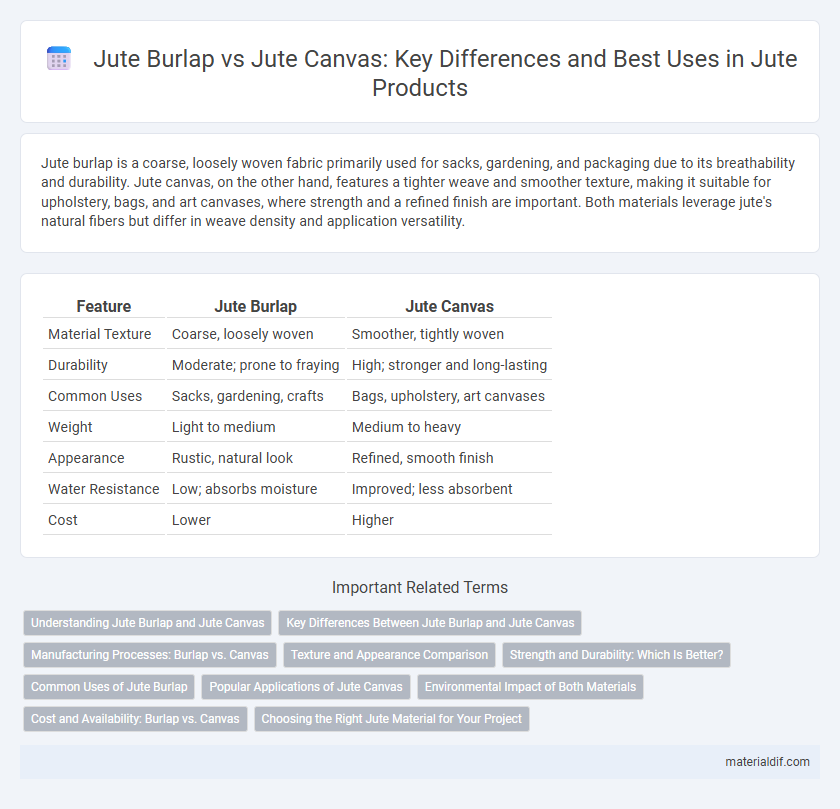Jute burlap is a coarse, loosely woven fabric primarily used for sacks, gardening, and packaging due to its breathability and durability. Jute canvas, on the other hand, features a tighter weave and smoother texture, making it suitable for upholstery, bags, and art canvases, where strength and a refined finish are important. Both materials leverage jute's natural fibers but differ in weave density and application versatility.
Table of Comparison
| Feature | Jute Burlap | Jute Canvas |
|---|---|---|
| Material Texture | Coarse, loosely woven | Smoother, tightly woven |
| Durability | Moderate; prone to fraying | High; stronger and long-lasting |
| Common Uses | Sacks, gardening, crafts | Bags, upholstery, art canvases |
| Weight | Light to medium | Medium to heavy |
| Appearance | Rustic, natural look | Refined, smooth finish |
| Water Resistance | Low; absorbs moisture | Improved; less absorbent |
| Cost | Lower | Higher |
Understanding Jute Burlap and Jute Canvas
Jute burlap, also known as hessian, is a coarse woven fabric primarily used for sacks, upholstery, and gardening applications due to its breathability and durability. Jute canvas, on the other hand, features a tighter weave and smoother texture, making it ideal for artistic canvases, bags, and upholstery where a finer finish is required. Understanding the key differences in weave density and texture helps in selecting the appropriate jute fabric for specific industrial or craft purposes.
Key Differences Between Jute Burlap and Jute Canvas
Jute burlap is a coarse, loosely woven fabric primarily used for packaging and upholstery due to its breathability and rough texture, while jute canvas is a tightly woven, heavier material suited for durable applications like bags and shoes. The key difference lies in weave density; burlap's open weave allows better airflow but lower strength, whereas canvas offers higher tensile strength and smoother texture. Moisture resistance is another factor, with jute canvas being more resilient against wear, making it preferable for heavy-duty use.
Manufacturing Processes: Burlap vs. Canvas
Jute burlap is produced using a loose, open weave that prioritizes breathability and flexibility, making it ideal for packaging and agricultural uses. In contrast, jute canvas undergoes a tighter, denser weaving process that enhances durability and water resistance, suitable for upholstery and heavy-duty applications. The manufacturing difference lies in the weaving tension and density, with burlap favoring simplicity and canvas focusing on structural strength.
Texture and Appearance Comparison
Jute burlap features a coarse, loosely woven texture with visible irregularities, providing a rustic and rough appearance ideal for decorative and agricultural uses. In contrast, jute canvas has a tighter, more uniform weave, resulting in a smoother surface with enhanced durability and a refined look suitable for upholstery and bags. The textural difference between burlap and canvas significantly influences their aesthetic appeal and functional applications in various industries.
Strength and Durability: Which Is Better?
Jute burlap is known for its coarse texture and moderate strength, making it ideal for packaging and lightweight applications. Jute canvas offers a denser weave and higher tensile strength, providing superior durability for heavy-duty uses such as upholstery and tote bags. When comparing strength and durability, jute canvas outperforms burlap due to its tighter construction and enhanced resistance to wear and tear.
Common Uses of Jute Burlap
Jute burlap is widely used in agriculture for sackcloth packaging, soil erosion control, and tree wrapping due to its breathable and biodegradable properties. Unlike jute canvas, which is thicker and more durable for upholstery and heavy-duty applications, burlap excels in garden and eco-friendly crafts. Its coarse texture and cost-effectiveness make jute burlap a preferred choice for rustic home decor and landscaping projects.
Popular Applications of Jute Canvas
Jute canvas is widely used in packaging, upholstery, and eco-friendly bags due to its durability and coarse texture, making it ideal for heavy-duty applications. Its breathability and natural resistance to moisture also benefit agricultural and horticultural uses, such as plant wraps and soil protection. Compared to jute burlap, jute canvas offers a tighter weave, enhancing its strength and suitability for decorative arts and crafts.
Environmental Impact of Both Materials
Jute burlap and jute canvas both stem from the natural jute fiber, making them biodegradable and eco-friendly alternatives to synthetic materials. Jute burlap production involves minimal chemical processing, resulting in a lower carbon footprint compared to jute canvas, which undergoes additional weaving and finishing treatments that may increase environmental impact. Both materials support sustainable agriculture by promoting renewable resources, but jute burlap's simpler manufacturing process typically offers a greener lifecycle from cultivation to disposal.
Cost and Availability: Burlap vs. Canvas
Jute burlap is generally more affordable and widely available compared to jute canvas due to its simpler weave and common usage in packaging and agriculture. Jute canvas, which features a tighter weave and smoother surface, tends to cost more and is less prevalent in the market, often used for higher-end applications like art canvases and upholstery. The cost difference is influenced by production complexity and demand, with burlap dominating in bulk supply chains while canvas serves more niche markets.
Choosing the Right Jute Material for Your Project
Jute burlap offers a coarse texture and high breathability, ideal for agricultural sacks, upholstery backing, and rustic decor projects, while jute canvas provides a tighter weave and greater durability suited for bags, upholstery, and art canvases. Selecting the right jute material depends on the desired strength, texture, and appearance, with burlap excelling in cost-effectiveness and biodegradability, whereas canvas offers enhanced resistance to wear and a smoother surface for printing. Consider project requirements like flexibility, environmental exposure, and aesthetic finish to determine the best jute fabric for optimal performance and sustainability.
Jute burlap vs Jute canvas Infographic

 materialdif.com
materialdif.com